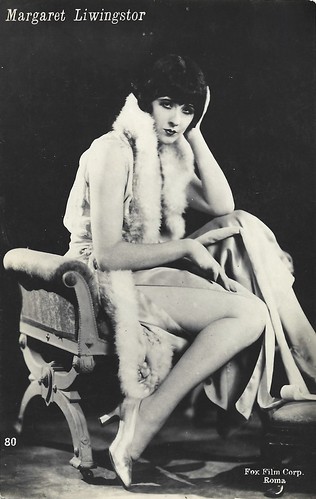
Italian postcard by Ed. Ballerini & Fratini, Firenze (B.F.F.), no. 80. Photo: Fox Film Corp., Roma.
Margaret Livingston (1895–1984) was an American film actress and businesswoman, most notable for her work during the silent film era, especially for Fox Film and Paramount. She remains best known today as "the Woman from the City" in F.W. Murnau's classic Sunrise: A Song of Two Humans (1927).
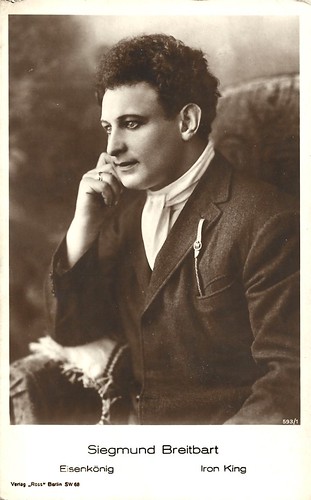
German postcard by Ross Verlag, no. 593/1, 1919-1924. Photo: Filmzentrale. Siegmund Breitbart in the Austrian film Der Eisenkönig/The Iron King (Max Neufeld, 1923).
Siegmund Breitbart (1893-1925), also known popularly as Zishe or Sische Breitbart (Yiddish: זישע ברייטבאַרט), was a Polish-born circus performer, vaudeville strongman and Jewish folklore hero. He was known as the "Strongest Man in the World" and "Eisenkönig" (The Iron King) during the 1920s.
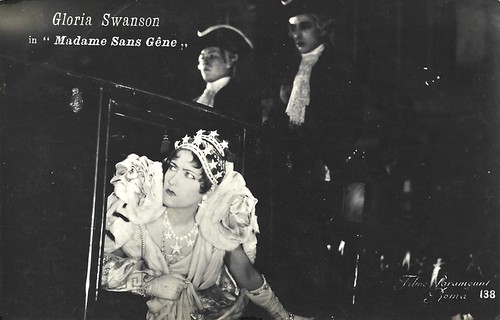
Italian postcard, no.138. Photo: Films Paramount, Roma. Gloria Swanson in the lost film Madame Sans-Gêne (Léonce Perret, 1925), entirely produced and filmed in France.
Gloria Swanson (1899-1983) was one of the biggest Hollywood stars of the silent era. She transformed from a typical Mack Sennett comedienne into a lively, provocative, even predatory, star in films by Cecil B. De Mille. She received Oscar nominations for Sadie Thompson (1928), The Trespasser (1929) and Sunset Blvd. (1950).

Italian postcard. Photo: First National. Jackie Coogan and Peaches Jackson in Circus Days (Edward F. Cline, 1923).
American actor John Leslie 'Jackie' Coogan (1914-1984) began as a child actor in silent films. He was Charlie Chaplin's irascible sidekick in The Kid (Charles Chaplin, 1921) and played the title role in Oliver Twist (Frank Lloyd, 1922). Many years later, he became known as Uncle Fester in the TV series The Addams Family (1964-1966). In the interim, he sued his mother and stepfather over his squandered film earnings ($48 million to $65 million adjusted for 2012 dollars) and provoked California to enact the first known legal protection for the earnings of child performers, widely known as 'the Coogan Act'.
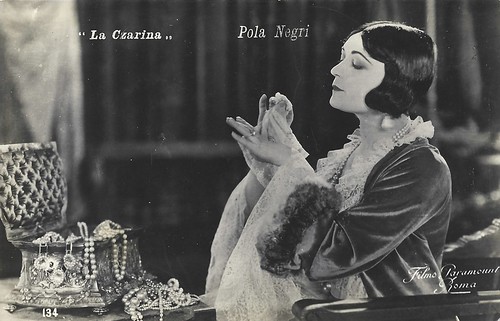
Vintage Italian postcard, no. 134. Photo: Films Paramount, Roma. Pola Negri in Forbidden Paradise (Ernst Lubitsch, 1924), launched in Italy as La Czarina.
Polish film actress Pola Negri (1897-1987) achieved notoriety as a femme fatale in German and American silent films between the 1910s and the 1930s.

German postcard by Ross Verlag, no. 4734/2, 1929-1930. Photo: Defina / First National.
American actress Colleen Moore (1899-1988) was a star of the silent screen who appeared in about 100 films beginning in 1917. During the 1920s, she put her stamp on American social history, creating in dozens of films the image of the wide-eyed, insouciant flapper with her bobbed hair and short skirts.
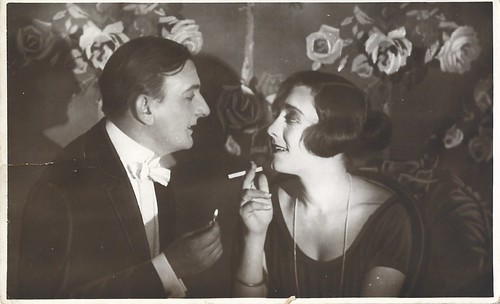
Italian postcard by Fert, card 8 of 12. Diomira Jacobini and Alberto Collo in L'isola della felicità (Luciano Doria, 1921), scripted by Nunzio Malasomma. Caption: The first glance.
Diomira Jacobini (1899-1959) was one of the stars of the Italian silent cinema. She was the younger sister of film diva Maria Jacobini, in whose shadow she always stayed even if she did some fascinating films herself. Diomira appeared in some 55 films in Italy, Germany and Denmark.
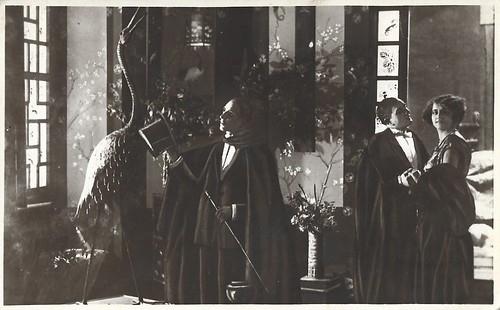
Italian postcard by Fert, card 11 of 12. Alberto Collo, Hella Andersen and Alfredo Martinelli in L'isola della felicità (Luciano Doria, 1921), scripted by Nunzio Malasomma. Caption: The happiness of one night.
Alberto Collo (1883-1955) was an Italian film actor of mostly silent cinema. In the 1910s and early 1920s, he acted opposite the female stars of his times. He also performed in war propaganda, historical films and strong men films.
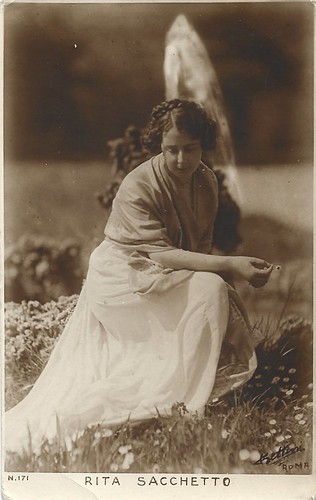
Italian postcard by Ed. Soc. An. Bettini, Roma, no. 171. Photo portrait by Riccardo Bettini, c. 1916.
German actress and dancer Rita Sacchetto (1879-1959) was in the 1910s a star of the Danish Nordisk Film Company.
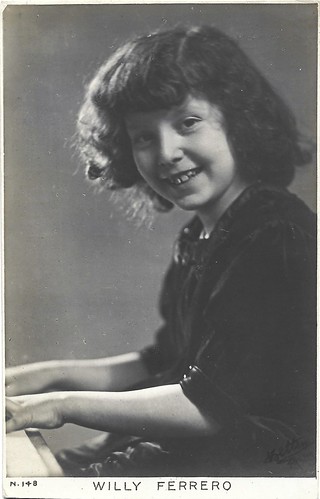
Italian postcard by Ed. Soc. An. Bettini, Roma, no. 148. Photo portrait by Riccardo Bettini, c. 1916.
Italian conductor and composer Willy Ferrero was born in Portland, Maine, in 1906 and was taken to Italy by his parents at the age of 2. He was a musical prodigy and directed several symphonic pieces at the Trocadero in Paris at the age of 3 years, 8 months. The great composer Massenet was among those who assisted at this concert and moved to the point of shedding tears he kissed the tiny director and exclaimed, “Go, you are born artist. Of you history will certainly speak”. At the age of 4, he led the orchestra in the Folies Bergère in Paris. Two years later, he directed his first symphonic concert in Rome at the Teatro Costanzi.
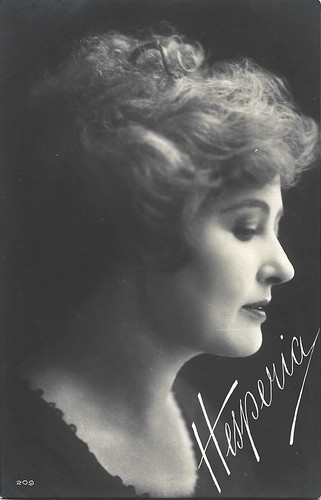
Italian postcard by Fotocelere, Torino, no. 209.
Hesperia (1885-1959) was one of the greatest divas of the Italian silent screen. She often worked with director Baldassarre Negroni, who later became her husband.
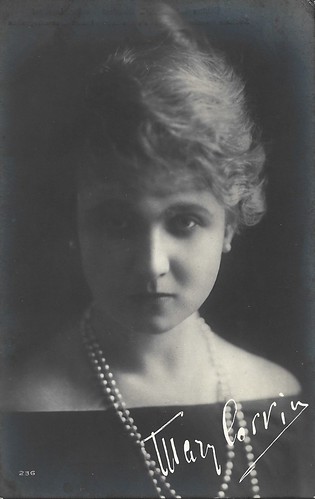
Italian postcard by Fotocelere / SARPAC Bucarest, no. 236.
Mary Corwyn aka Mary Corvin and Maria Corvin (1895-?) was a Polish actress, active in Italian silent film. Born Maria Breninski / Breninki in Warsaw, Poland, she was widowed at a young early age and arrived in Italy on a British ship. She was noted in Neapolitan literary circles. In 1916 she was hired by the Neapolitan film company Polifilms, where she acted in 7 films directed by Giulio Antamoro, and distributed by Lombardo Film. She became the 'first actress' at Polifilm, thanks to her blue eyes and photogenic qualities. In 1918, journalist Edoardo Scarfoglio brought her to writer-producer-actor Lucio d'Ambra, who hired her for his Roman film company Do-Re-Mi. She debuted there in Napoleoncina/L'épopée de Napoléonnette (Lucio D'Ambra, 1918), on a young girl smitten with Napoleon and his modern lookalike Dr. Toccasana.

Italian postcard by Fotocelere, Torino, no. 179.
Italian Yvonne De Fleuriel (1889-1963) was a singer and actress of variety and silent films. She was very popular during the Belle Epoque.

Italian postcard by Ed. Ballerini & Fratini, Firenze.
Anna Fougez (1894-1966) was a vaudeville star who shone on the Italian stage from the First World War to the mid-1920s. She also played in various Italian films.
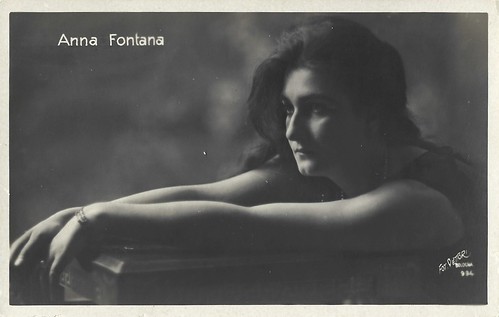
Italian postcard, no. 934. Photo by Vettori, Bologna.
Anna Fontana (1902-1974) was an Italian stage actress of the later 1920s and early 1930s, who also acted in one film, Il richiamo del cuore (1930).
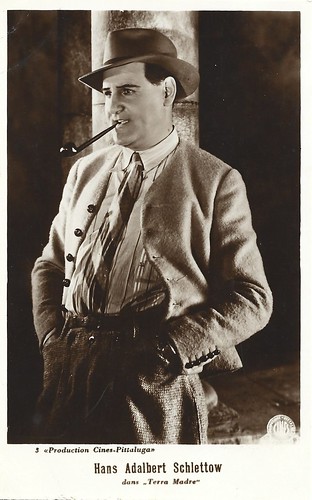
Italian postcard (despite the French text) by Cines-Pittaluga, no. 3. Hans-Adalbert Schlettow in the German language version of Alessandro Blasetti's Terra madre/Mother Earth (1931): the German early sound film Kennst Du das Land (Constantin J. David, 1931), shot simultaneously with the Italian version in Italy.

Italian postcard by Cines-Pittaluga, no. 4. Eduard von Winterstein in the German language version of Alessandro Blasetti's Terra madre/Mother Earth (1931): the German early sound film Kennst Du das Land (Constantin J. David, 1931).
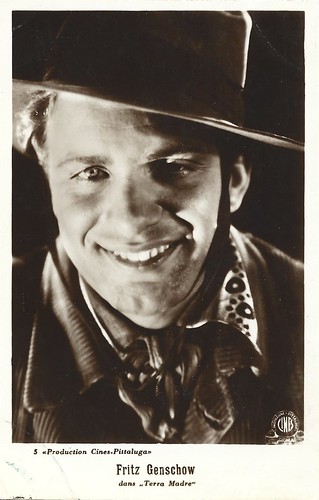
Italian postcard by Cines-Pittaluga, no. 5. Fritz Genschow in the German language version of Alessandro Blasetti's Terra madre/Mother Earth (1931): the German early sound film Kennst Du das Land (Constantin J. David, 1931).
No comments:
Post a Comment